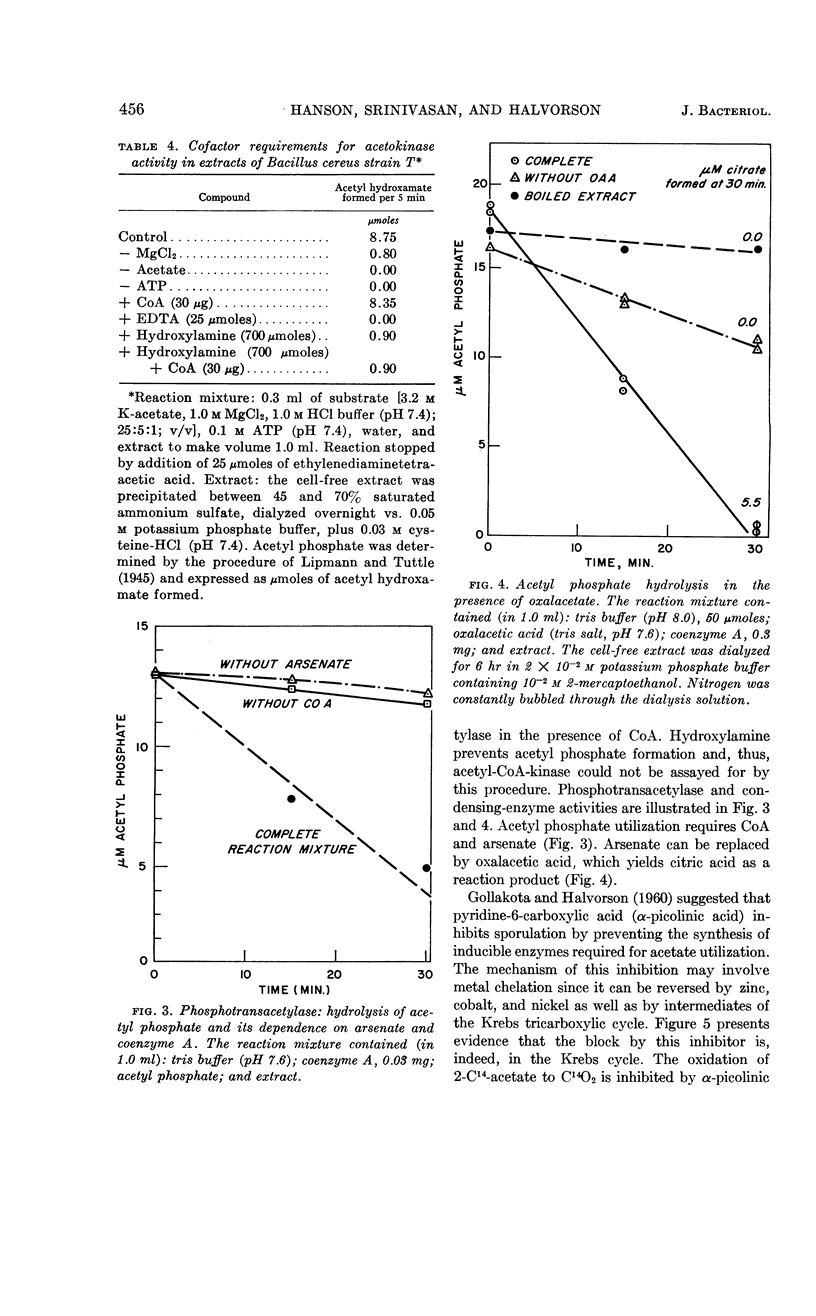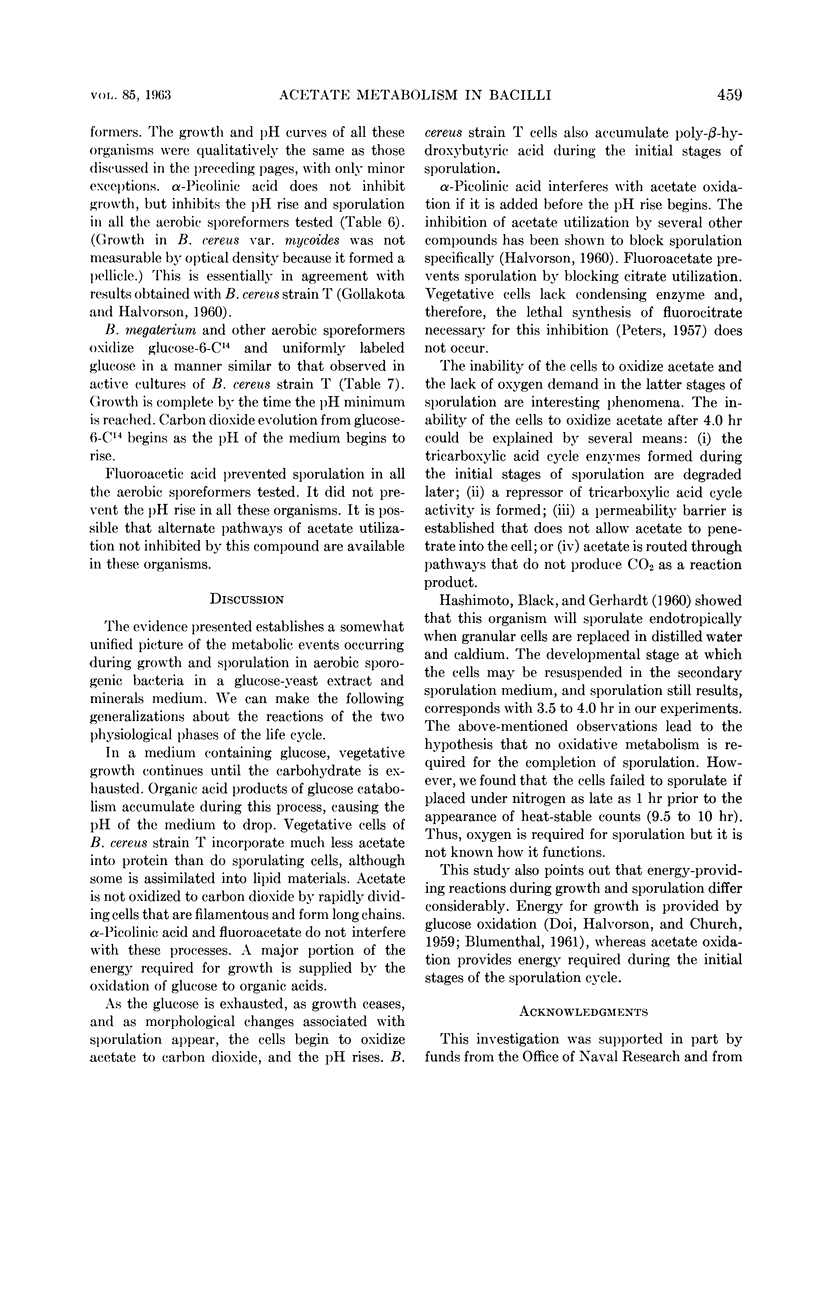Abstract
Hanson, Richard S. (University of Illinois, Urbana), V. R. Srinivasan, and H. Orin Halvorson. Biochemistry of sporulation. I. Metabolism of acetate by vegetative and sporulating cells. J. Bacteriol. 85:451–460. 1963.—The transition from the vegetative to the sporulating cycle in a sporeformer is marked by a change in the enzymatic machinery of the cell. When vegetative cells of Bacillus cereus strain T are grown in a glucose-yeast extract-minerals medium, acetate accumulates until the beginning of the sporulation cycle. The acetate-activating systems are present in the vegetative cells as well as in the cells of the early stages of sporulation, whereas the enzymes necessary for the terminal oxidation of acetate to carbon dioxide are absent in the vegetative stage. The induction of a functional tricarboxylic acid cycle during early sporulation is inhibited by chloramphenicol. α-Picolinic acid also prevents morphological, as well as physiological, changes during the transition.
Full text
PDF









Selected References
These references are in PubMed. This may not be the complete list of references from this article.
- AMAHA M., ORDAL Z. J., TOUBA A. Sporulation requirements of Bacillus coagulans var. thermoacidurans in complex media. J Bacteriol. 1956 Jul;72(1):34–41. doi: 10.1128/jb.72.1.34-41.1956. [DOI] [PMC free article] [PubMed] [Google Scholar]
- BECK E. S., LINDSTROM E. S. The oxidative metabolism of Bacillus cereus. J Bacteriol. 1955 Sep;70(3):335–338. doi: 10.1128/jb.70.3.335-338.1955. [DOI] [PMC free article] [PubMed] [Google Scholar]
- BUSCH H., HURLBERT R. B., POTTER V. R. Anion exchange chromatography of acids of the citric acid cycle. J Biol Chem. 1952 May;196(2):717–727. [PubMed] [Google Scholar]
- CHARNEY J., FISHER W. P., HEGARTY C. P. Managanese as an essential element for sporulation in the genus Bacillus. J Bacteriol. 1951 Aug;62(2):145–148. doi: 10.1128/jb.62.2.145-148.1951. [DOI] [PMC free article] [PubMed] [Google Scholar]
- DOI R., HALVORSON H., CHURCH B. Intermediate metabolism of aerobic spores. III. The mechanism of glucose and hexose phosphate oxidation in extracts of Bacillus cereus spores. J Bacteriol. 1959 Jan;77(1):43–54. doi: 10.1128/jb.77.1.43-54.1959. [DOI] [PMC free article] [PubMed] [Google Scholar]
- GOLLAKOTA K. G., HALVORSON H. O. Biochemical changes occurring during sporulation of Bacillus cereus. Inhibition of sporulation by alpha-picolinic acid. J Bacteriol. 1960 Jan;79:1–8. doi: 10.1128/jb.79.1.1-8.1960. [DOI] [PMC free article] [PubMed] [Google Scholar]
- HARDWICK W. A., FOSTER J. W. Enzymatic changes during sporogenesis in some aerobic bacteria. J Bacteriol. 1953 Apr;65(4):355–360. doi: 10.1128/jb.65.4.355-360.1953. [DOI] [PMC free article] [PubMed] [Google Scholar]
- HASHIMOTO T., BLACK S. H., GERHARDT P. Development of fine structure, thermostability, and dipicolinate during sporogenesis in a bacillus. Can J Microbiol. 1960 Apr;6:203–212. doi: 10.1139/m60-022. [DOI] [PubMed] [Google Scholar]
- NAKATA H. M., HALVORSON H. O. Biochemical changes occurring during growth and sporulation of Bacillus cereus. J Bacteriol. 1960 Dec;80:801–810. doi: 10.1128/jb.80.6.801-810.1960. [DOI] [PMC free article] [PubMed] [Google Scholar]
- PETERS R. A. Mechanism of the toxicity of the active constituent of Dichapetalum cymosum and related compounds. Adv Enzymol Relat Subj Biochem. 1957;18:113–159. doi: 10.1002/9780470122631.ch3. [DOI] [PubMed] [Google Scholar]
- STERN J. R., OCHOA S., LYNEN F. Enzymatic synthesis of citric acid. V. Reaction of acetyl coenzyme A. J Biol Chem. 1952 Sep;198(1):313–321. [PubMed] [Google Scholar]


